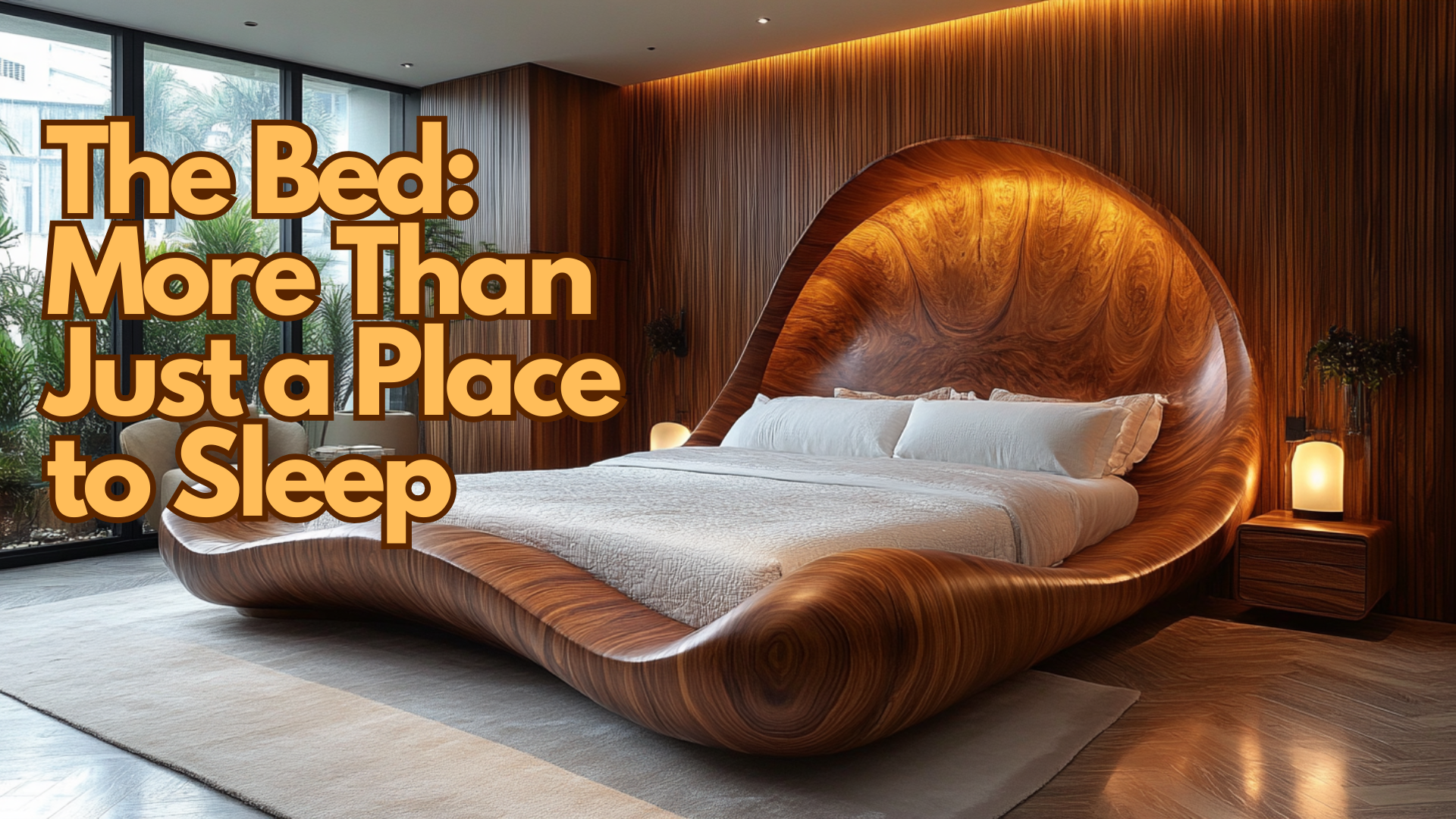
click the link to get your Yaheetech Queen Solid Pine Wood Platform Bed Frame – Reserved Holes for Headboard, Wooden Slats Support, 7.5″ Clearance, No Noise, Easy Assembly – Smoked Walnut https://amzn.to/4fn5lfj
The Bed: More Than Just a Place to Sleep
A bed is much more than a simple piece of furniture—it’s a sanctuary, a retreat, and a vital part of our daily lives. Whether it’s a cozy single bed in a child’s room or an expansive king-sized mattress in a master suite, the bed is a central element in both our physical well-being and our emotional comfort. In this article, we’ll explore the evolution, types, and importance of beds, along with tips on creating the perfect sleep environment.
The History of the Bed: From Simple Slats to Luxurious Designs

click the link to get your SHA CERLIN 14 Inch Queen Size Metal Platform Bed Frame with Wooden Headboard and Footboard, Mattress Foundation, No Box Spring Needed, Large Under Bed Storage, Non-Slip Without Noise, Walnut https://amzn.to/3UUUQaS
The bed, as we know it today, has a rich and fascinating history. Early humans slept on the ground or in simple forms made from leaves, animal skins, or straw. In ancient Egypt, beds were often constructed from wood and used mattresses filled with straw or reeds, offering a more comfortable sleep surface than the cold earth. The Romans and Greeks introduced raised beds, made of wood or metal, with elaborate designs and the addition of pillows for comfort.
During the Middle Ages, the bed became a more elaborate symbol of status, with grand canopy beds used by royalty and nobility. These beds featured curtains for privacy and warmth, and mattresses were filled with luxurious materials such as feathers, wool, or horsehair. In the 19th century, the industrial revolution brought about innovations in bed design, such as the coil spring mattress, which revolutionized the comfort and durability of bedding.
Today, the bed has evolved into a wide range of forms, styles, and materials. From minimalist frames to ornate four-poster beds, there’s a bed to suit every taste and every function. But regardless of its design, the bed remains a cornerstone of our daily lives.
Types of Beds: Choosing the Right One for Your Needs

click the link to get your Mellow Naturalista Classic 16 Inch Solid Wood Platform Bed with Wooden Slats, Natural Pine, King https://amzn.to/4fwbXIa
When it comes to choosing a bed, there are several types and styles to consider, each with its unique advantages. The best bed for you will depend on your space, budget, and personal preferences.
1. Platform Beds
Platform beds are characterized by their low profile and solid base, eliminating the need for a box spring. These beds often feature sleek, modern designs and are ideal for people who appreciate a minimalist look. The absence of a box spring also allows for additional storage space underneath the bed, making them a practical option for smaller rooms.
2. Panel Beds
Panel beds are the traditional bed design, featuring a flat or slightly slanted headboard and footboard, with a frame that supports a mattress and box spring. This type of bed is often found in both contemporary and classic designs, and it provides a more elevated sleeping experience. Panel beds are versatile and can complement various bedroom styles.
3. Canopy Beds
Canopy beds are dramatic and elegant, featuring four posts that extend upwards, with the option to drape fabric across the top for a luxurious look. Often associated with royalty and old-world charm, canopy beds can create a cozy, intimate space in a bedroom, perfect for those who want to add a touch of romance or grandeur to their room.
4. Bunk Beds
Bunk beds are a practical solution for shared spaces, especially in children’s rooms or dormitories. These beds stack one bed over another, allowing for maximum floor space. Bunk beds come in a variety of configurations, including twin-over-twin, twin-over-full, or even lofted beds with a workspace or seating area underneath.
5. Murphy Beds
Murphy beds, also known as wall beds, are foldable beds that can be stored vertically against a wall or inside a cabinet when not in use. These beds are ideal for small apartments, guest rooms, or multi-functional spaces, as they save valuable floor space during the day.
6. Adjustable Beds
Adjustable beds offer the ability to customize your sleeping position. These beds allow you to elevate the head or foot of the mattress, which can be especially beneficial for people with certain health conditions such as acid reflux, sleep apnea, or back pain. Adjustable beds are often paired with memory foam or hybrid mattresses for the ultimate comfort.
7. Day Beds
Day beds are versatile pieces of furniture that can function as both a couch and a bed. These are typically found in smaller rooms or as a secondary sleeping arrangement. Day beds can be styled with cushions and throws, making them a comfortable seating option during the day and a cozy bed for guests at night.
The Importance of a Good Mattress

click the link to get your Zinus Ellie 14 Inch Bamboo Platform Bed Frame, Wood Slat Support, No Box Spring Needed, Easy Assembly, Queen https://amzn.to/3UU9Rd3
No matter how beautiful or stylish your bed frame is, the mattress is the true foundation of a good night’s sleep. The mattress you choose has a significant impact on your comfort, health, and overall sleep quality. There are several types of mattresses, each catering to different preferences and sleep needs:
1. Innerspring Mattresses
Innerspring mattresses are the traditional choice, featuring a system of coil springs inside the mattress to provide support. These mattresses are widely available and come in a variety of firmness levels. They are generally bouncier and provide good airflow, which can be ideal for people who sleep hot.
2. Memory Foam Mattresses
Memory foam mattresses are known for their ability to contour to the shape of your body, providing excellent pressure relief. These mattresses are a popular choice for people with joint pain or back issues. However, they can retain heat, so cooling options are available for those who tend to sleep warm.
3. Hybrid Mattresses
Hybrid mattresses combine the support of innerspring coils with the comfort of memory foam or latex. These mattresses offer the best of both worlds—providing both pressure relief and durability. They are a good choice for people who want a balance of comfort and support.
4. Latex Mattresses
Made from natural or synthetic latex, these mattresses are highly durable and provide excellent support. Latex is also naturally resistant to dust mites and mold, making it a great choice for people with allergies. Latex mattresses tend to be cooler than memory foam and offer a more responsive feel.
5. Air Mattresses
Air mattresses use adjustable air chambers to control firmness levels. These mattresses can be customized to suit individual preferences, making them ideal for couples with different sleep needs. Air mattresses are often used in temporary or guest bedroom setups, though some high-end models are designed for permanent use.
Creating the Perfect Sleep Environment

click the link to get your LIKIMIO California King Bed Frame with Headboard and Footboard, Metal Strong Supports, Easy Assembly, Noise-Free, No Box Spring Needed, Vintage Brown https://amzn.to/3ZbLQRo
The bed is just one part of creating the ultimate sleep environment. To optimize your bedroom for restful sleep, consider the following elements:
1. Bedding
The right bedding—sheets, blankets, duvets, and comforters—can make a huge difference in your sleep quality. Opt for breathable fabrics such as cotton or linen to promote air circulation and keep you cool during the night. Layer your bedding to adjust to different seasons: lightweight blankets for summer and heavier duvets for winter.
2. Pillows
The right pillow supports your head and neck while you sleep. There are various types of pillows, including memory foam, down, and hypoallergenic options. Choose one that aligns with your sleeping position (side, back, or stomach) to prevent neck pain and ensure comfort.
3. Lighting
Soft, ambient lighting in the bedroom promotes relaxation and helps signal to your body that it’s time to wind down. Consider dimmable lamps or nightlights for a peaceful atmosphere. Avoid bright or harsh lighting, especially in the hour or two before bed, as it can interfere with your sleep cycle.
4. Room Temperature
The ideal sleeping temperature is between 60-67°F (15-20°C). A cool room helps lower your body temperature, signaling that it’s time to rest. Use fans, air conditioning, or open windows to keep the room cool, and adjust your bedding accordingly.
5. Noise Reduction
Reducing noise can improve the quality of your sleep. White noise machines, fans, or soundproofing the room with thick curtains can help mask disruptive noises and create a quiet, peaceful sleeping environment.
Conclusion: The Bed as a Key to Restful Sleep

click the link to get your ZINUS Mia Metal Platform Bed Frame, Wood Slat Support, No Box Spring Needed, Easy Assembly, Black, Queen https://amzn.to/48QQEi9
The bed plays a crucial role in our overall health and well-being. Whether you’re looking for a sleek, modern platform bed or a traditional, cozy canopy design, choosing the right bed and mattress is key to ensuring a restful night’s sleep. By understanding the different types of beds, mattresses, and bedding options available, you can create the perfect sleep environment that supports not only comfort but also the quality of your rest. After all, a good night’s sleep is essential for physical health, mental clarity, and emotional well-being.

click the link to get your LIKIMIO King Size Bed Frame, Storage Headboard with Charging Station, Solid and Stable, Noise Free, No Box Spring Needed, Easy Assembly https://amzn.to/4hVGGA3
click here to get your Amazon Fire TV Stick 4K Max streaming device (newest model) supports Wi-Fi 6E, free & live TV without cable or satellite https://amzn.to/4fItME2





Good day very cool website!! Guy .. Beautiful .. Superb .. I will bookmark your site and take the feeds additionallyKI am glad to find so many useful information right here in the post, we need work out more strategies on this regard, thanks for sharing. . . . . .
This website online is really a stroll-via for the entire information you needed about this and didn’t know who to ask. Glimpse here, and you’ll definitely discover it.
I’ll right away clutch your rss as I can not to find your e-mail subscription link or e-newsletter service. Do you have any? Kindly allow me understand in order that I may just subscribe. Thanks.
I went over this site and I believe you have a lot of fantastic info , saved to favorites (:.
This actually answered my downside, thanks!
I am curious to find out what blog system you happen to be using? I’m having some minor security problems with my latest site and I would like to find something more risk-free. Do you have any suggestions?
Thanks for posting. I really enjoyed reading it, especially because it addressed my problem. http://www.hairstylesvip.com It helped me a lot and I hope it will help others too.